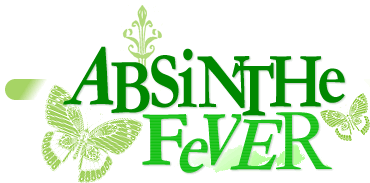
Absinthe is a drink that can be enjoyed in a surprising number of ways. Most absintheurs drink absinthe the traditional way: louched with water poured over a cube of white sugar. Some drink absinthe that was poured over sugar that is subsequently set alight (though absinthe purists decry this practice), and a few even like drinking absinthe neat (brave souls!). Absinthe cocktails, too, have long been a favourite way to enjoy this special drink. More recently, absinthe even found its way into ice cream sundaes and Swiss chocolates.
How you enjoy your absinthe is a matter of preference, therefore, as is the time, the occasion or indeed the frequency. Absinthe is currently becoming the drink of choice at grand dinner parties, where it provides refreshment before, during and after the meal: as a pre-dinner drink, in mid-course sorbet, and as a digestive. That is a whole lot of absinthe -- and we'll drink to that!
Originally, the absinthe drink was intended as an aperitif. The bars and cafes of fin de siecle Paris celebrated the "Green Hour", a late-afternoon period when Parisians downed their pre-dinner glass (or three) of the green liquor.
In the age of the original absinthe fever, the drink was always diluted with water and sweetened with sugar before consumption. First, a cube of sugar was placed on a perforated spoon resting on the top of a glass of neat absinthe. Then, chilled water was slowly poured over the sugar until it dissolved and the required level of dilution was achieved. Special absinthe fountains -- decorated containers that dispensed iced water -- had their firm place in most drinking establishments of that time. (*Note: We have more information on the original absinthe ritual, with a how-to guide and tips.)
A few variations on the traditional drinking ritual have popped up since. One recent method involves pouring absinthe itself -- rather than water -- over the cube of sugar, then setting fire to the absinthe-soaked cube. Purists and absinthe snobs condemn this method and resolutely declare that one should never drink absinthe like that. But that hasn't stopped some drinkers taking the "fire ritual" further still: the sugar cube goes out of the metaphorical window, and the emerald liquor itself is set on fire (just like sambucca).
Although involving absinthe with fire may have the desired visual effect in a hip cocktail lounge or on the movie screen, it does deny the drinker the full experience of the more noteworthy mind-opening, perception-enhancing absinthe effects. The traditional ritual of 1890's Paris had a purpose: as cool water drips into a glass of the chartreuse green liquor, it liberates the all-important essential herbal oils that make absinthe the special drink it is.
For the same reason, absinthe is seldom drunk straight-up like scotch or brandy. Newcomers to absinthe often drink absinthe neat, but this is rarely for the taste, but simply because they do not know there is another way. Even modern-day bartenders sometimes produce a whisky glass with a shot of the green liquid when asked for "absinthe". If this happens to you, at least request a wine glass and a bottle of chilled water -- then pour the shot of absinthe into the wine glass and slowly dilute with water.
If you are one of those people who actually like to drink absinthe neat, by all means continue doing so, and do not let anyone tell you of the "right ways" or the "wrong ways". Freedom, after all, is the very essence of the Green Fairy, so be free to enjoy her company as you wish.
If you are new to absinthe and want to try the drink straight-up (who knows, you might develop the taste for it?), note that meeting the Green Fairy can prove an intoxicating experience in more than the metaphorical sense: absinthe does contain a lot of alcohol, 50 to 70 per cent being the norm (in contrast, a decent scotch is "mere" 40%).

Got something to say about drinking absinthe?
At Absinthe Fever, we encourage you to get involved. In fact, this whole site is meant as an open forum about absinthe, because we believe that absinthe is more than a drink, or a bit of thujone in a bottle. The Green Fairy -- the affectionate name given to the absinthe drink in the 19th century -- is art, poetry, experience, lifestyle... So join us and share your thoughts anywhere on Absinthe Fever!
24 people have
posted messages
to this page.
Read messages (24)
Post your message
Copyright © 2006 AbsintheFever.com Contributors.
All Rights Reserved.


About drinking absinthe
The Buy Absinthe .Net guide has further tips on how to make a glass of absinthe in the traditional French manner, plus some amusing pieces of trivia about the absinthe-drinking culture of the 19th century. The same page also gives recipes for a few classic absinthe cocktails you might want to try. 'Death in the Afternoon' anyone?




What is absinthe?
What is the history of absinthe?
What is wormwood?
How about thujone?
What are the effects of absinthe?
How do I drink absinthe?
What is "La Louche" ritual?
What is an absinthe fountain?

The freedom-loving Green Fairy...
Goddess of rebel poets & artists in France and beyond
in France and beyond